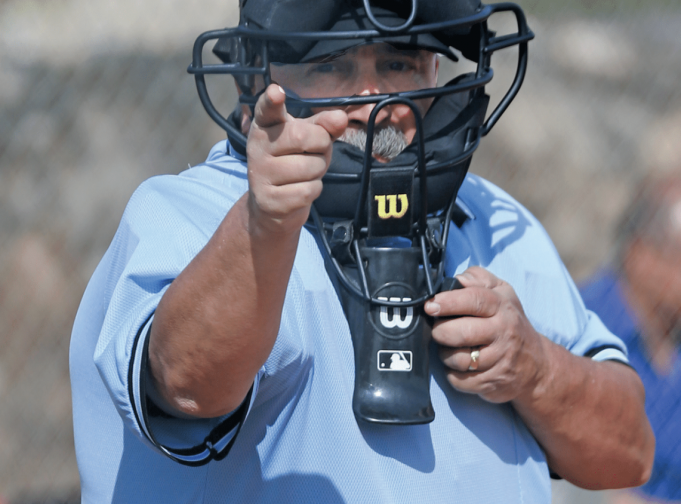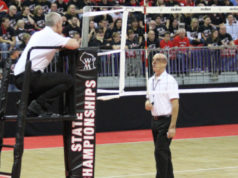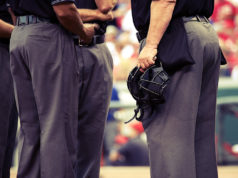One of the great debates in sports these days is how long it takes to play the games. Television has been a great boon to schools and pro leagues, what with oodles of sponsor money rolling in. But the downside has been turning a two-and-a-half-hour joy into a three-and-a-half-hour ordeal.
MLB and NCAA football in particular have devised rules designed to speed up the games. It remains to be seen if those rules will work in the long run or if they need tweaking to be truly effective.
Games generally start to drag because of one of two reasons: either the teams aren’t up to the desired pace or the officials allow it to happen. In the first case — OK, if a quarterback is three-for-63 throwing out of the shotgun, there’s little you can do to make time move faster. But there’s a lot you can do to shorten the length of time between plays — some within the rules and some out of sympathy for your fellow man. When, instead, the officials start letting it drag, sometimes it’s poor mechanics or conditioning. More often, though, it’s weak game management and not recognizing or not responding to slow play that’s deliberate. Games go bad the longer you allow the players to stand around and think about things like why they hate life. So, if players or coaches are deliberately letting the air out of the tires, put a stop to it.
Volleyball is meant to be played briskly. When the coach suddenly can’t keep the rotation straight in her head after she’s used up her timeouts, someone pays. When somebody’s serving, five seconds means five seconds and everyone expects you to do something about the goldbrickers. It’s no oxymoron to say that the best way to speed a game up is to slow down at the right time: You stop the game for a moment, make a point of telling the captain or coach what has to change so that all creation knows, and then you plan to act on your promise. It’s that simple.
In many sports we associate long games with brilliant strategy. A four-and-a-half-hour Yankees-Red Sox game is now “epic baseball” when it used to be “paint drying.” Hey, the Giants once beat the Phillies, 6-1, in 51 minutes. It was getting dark and everyone had a train to catch. Where there’s a will there’s a way. It’s up to officials, more often than they now do, to provide that will sometimes.
It’s the officials’ job not so much to read the minds of players and coaches but to discern their motives when it comes to slowing down a game. You can tell when two teams just aren’t up to it and nothing but CPR will help. The rest of the time, you have to use the rules to your advantage to keep things moving.
Let’s look at some strategies that work:
Get the support people involved. Don’t let the outfielders chase foul balls. Don’t let your back judge fish every incomplete pass out of the steeplechase pit. If they give you four balls to use, get the ball chasers, the substitutes or energetic team moms — whatever the rules allow — involved in getting a fresh ball in play while the old one is safely removed in record time.
Use the timing rules to your advantage. Keep the timeouts, intermissions and the time you spend between plays to an enforceable minimum. You probably won’t get any holiday cards if the sound of the second warning in basketball is your cue to put the ball on the floor the first time you get a chance. But you can make it abundantly clear that you’re willing to start doing it by using your voice and physically intervening in huddles, right from the start. Most coaches aren’t stupid; they often act that way when it suits them. They usually respect fair warning, especially when they later see that both they and the other team are suffering equally.
If the ball’s been spotted in football, start the play clock. If everyone’s in a lane space, bounce the ball to the shooter. Don’t meditate. Put the pressure on the people causing the problem. Make them play to your pace, but make sure your crew’s mechanics are up to the line you draw in the sand.
If you aren’t sure, they’re probably delaying. That probably sounds heretical to a lot of us. Since we’re usually honest people ourselves, it sticks in our craw to think about suggesting players or coaches aren’t. But we’re not talking about cheating here; we’re talking about the tactical bending of rules: Most of us would call it “creative” to try a hidden ball play in baseball, right? Why, then, is it suddenly “coincidence” that the pitcher’s shoe keeps coming undone once he’s up over 80 pitches and has the bases loaded? You’ve got to get psychology working for you in such cases and bend the rules back on your terms. Be a little cynical and ask what you would do if you were looking for an edge in the situation before you. Then go with it. You won’t always be right but the coaches will eventually figure out that you’re acting on behalf of the game. They’ll huff and they’ll puff, but they’ll seldom blow your house down. Take a stand.
If you believe your only job is to sneak in, call plays and sneak out unnoticed, you probably won’t get far as an official. And if your solution to every issue would make a despot proud of you, you’re headed for the same reef. Make sure the teams understand that you have a comfortable grip on the game and are willing to do what you have to maintain it. The best way to keep order is to keep the coaches coaching, the players playing and the fans … fanning. Use your ingenuity to keep the game moving at a fair pace and you’ll find other problems you used to have going away.
What's Your Call? Leave a Comment:
Note: This article is archival in nature. Rules, interpretations, mechanics, philosophies and other information may or may not be correct for the current year.
This article is the copyright of ©Referee Enterprises, Inc., and may not be republished in whole or in part online, in print or in any capacity without expressed written permission from Referee. The article is made available for educational use by individuals.
















